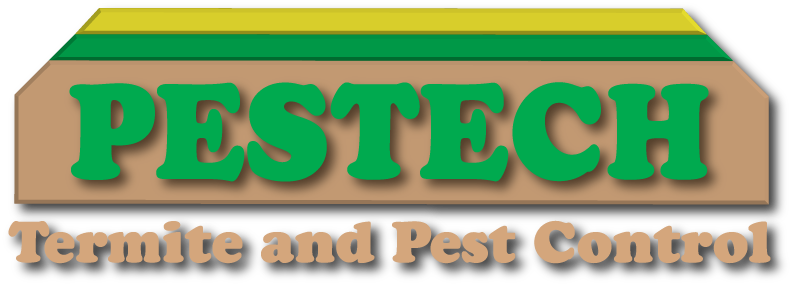Pest Identification Guide
Acrobat Ant
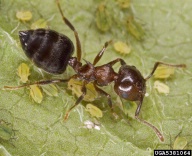
|
Physical Description:
Similar to Carpenter Ants but much smaller, about 1/8" in size with a heart-shaped abcomen raised above main body. Vary in color from yellowish to dark brown with the abdomen darker than the rest of the body.
Damage:
Pests mainly by their presence in and around structures. Workers may become aggressive and sting or bite if disturbed. May also produce a foul odor, though this is rare. Structural damage is minimal. |
Argentine Ant
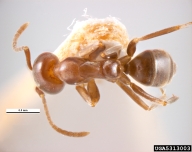 |
Physical Description:
Wingless workers are 1/12 to 1/8 inch long and light to dark brown in color. Have a single node in the waist and tend to travel in trails.
Damage:
Has been known to go to great lengths to get to a food source. Will enter a refrigerator or follow the spiral of screw-top jars. May enter beds at night in search of the moisture of human bodies. Rarely bite but are nuisance in the home and can be difficult to control. |
Big-Headed Ant
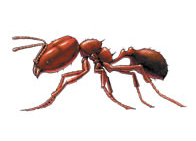 |
Physical Description:
Light brown to dark reddish brown in color. Major workers heads are very large in proportion to their bodies.
Damage:
May cause damage in the home by eating foods and filling up voids in walls with their carcasses sometimes causing electrical short circuits. |
Carpenter Ant
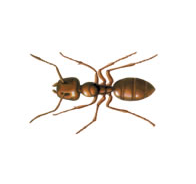
|
Physical Description:
Often called the "Big Black Ant" though some subspecies may be reddish-brown in color. Size may range from 1/4 to 3/4 inch. May see either wingless workers or winged reproductive ants from the colony.
Damage:
Most common is wood damage characterized by smooth, clean galleries and small windows or slit-like openings. The slits act as disposal chutes for frass and other materials. Wood damage is often not visible unless the wall or ceiling cavities are opened up. |
Odorous House Ant
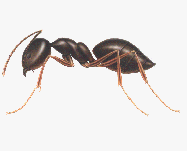
|
Physical Description:
Tiny ant, less than 1/16th of an inch long. Brown to black in color with one node and an uneven thorax when viewed from the side. Produces a foul smell like "rotten coconut" when crushed.
Damage:
|
Pavement Ant
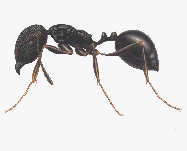
|
Physical Description:
Approximately 1/8 inch in length, dark brown to black in color. Have a body with two nodes and a 12 segmented antenna with a 3-segment club.
Damage:
|
Pharaoh Ant
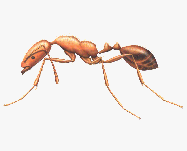
|
Physical Description:
About 1/16th inch long, light yellow to red with black markings on the abdomen. Have two nodes between the abdomen and thorax. Workers are all the same size. Often confused with the Thief Ant but has 12 segmented antennae instead of the 10 of the Thief Ant.
Damage:
Can get into foodstuffs and have been known to gnaw holes in rayon, silk, and rubber items. They can also transmit diseases and contaminate sterile materials. |
Thief Ant
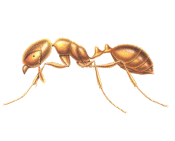
|
Physical Description:
One of the smallest household ants at 1/32 of an inch, light yellow to red with black markings on the abdomen. Two nodes between the abdomen and thorax. Workers are all the same size.
Damage:
|
American Cockroach
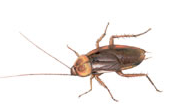
|
Physical Description:
Reddish-brown with a pale brown or yellow border on upper surface. About 1 1/2 inches long or longer. Have wings but seldom fly.
Damage:
Have the ability to multiply quickly and can be a nuisance in large numbers. Intrude on homes, contaminate food and can transmit diseases. |
Drugstore Beetle
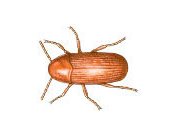
|
Physical Description:
Damage:
|
German Cockroach
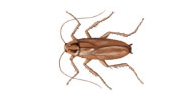
|
Physical Description:
1/2 to 5/8 inch long, light to medium brown with 2 dark stripes behind the head. Nymphs are wingless, smaller and much darker in color with light stripe on back.
Damage:
Can multiply quickly and are a nuisance in large numbers.They are unsightly, contaminate food and are capable of transmitting diseases. |
Oriental Cockroach
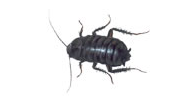
|
Physical Description:
Shiny black or very dark brown in color. Females can be about 1.25 inches, males 1 inch. Has wings but cannot fly.
Damage:
|
Rice Weevil
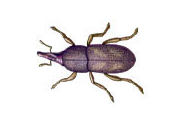
|
Physical Description:
Damage:
|
Black Widow
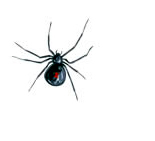
|
Physical Description:
Female has shiny black body with red hourglass on abdomen. Male has shiny black body with yellow and red bands on its back. Male has a body about half the size of the female and legs twice as long.
Damage:
Bite contains venom 15 times more potent than rattlesnakes. First sign of bite is localized swelling, often with two red spots in the center. Symptoms can include aching of the body (especially legs), partial paralysis, sweating and swollen eyelids. Symptoms generally last 2-3 days, HOWEVER: IF YOU BELIEVE YOU HAVE BEEN BITTEN BY A BLACK WIDOW, CALL YOUR DOCTOR IMMEDIATELY. |
Brown Recluse
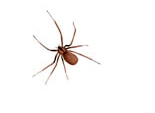
|
Physical Description:
Light tan to brown in color and between 1/4 and 3/4 inch long with a diameter of 1 inch including the legs. Markings behind head appear in a violin pattern pointing to the rear of the spider.
Damage:
Actual bites are rare but the venom can cause very serious side effects and infestations must be taken seriously. IF YOU THINK YOU HAVE BEEN BITTEN CALL YOUR DOCTOR IMMEDIATELY. |
Bottle Fly
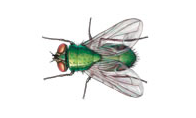
|
Physical Description:
Part of the family of common, large flies with a metallic blue, green, bronze, or black sheen. Make an audible bussing sound especially when flying near windows.
Damage:
Belongs to a family of filth flies, originating in filth and carrying diseases that may be transmitted to humans through either surface or food contamination. |
Drain Fly
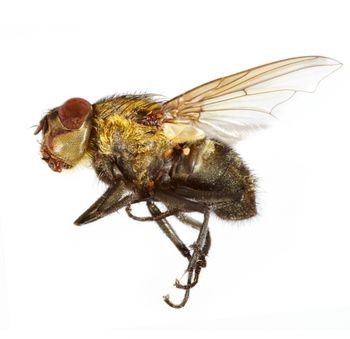
|
Physical Description:
Only 1/5 to 1/6 inch in length. Body is dark or grayish in color and appears fuzzy. Wings appear moth-like and too large for the body. Fly in a jerky, irregular pattern.
Damage:
Become a nuisance by sheer numbers. Originate in filth and carry diseases that can possibly be transmitted to humans. Large numbers may cause or intensify Asthma symptoms. |
Fruit Fly
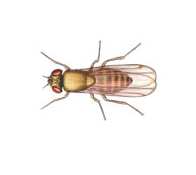
|
Physical Description:
1/8 inch in length, smallest fly found in homes. Bright beady red eyes with light yellow or tan body.
Damage:
Breed rapidly and can be a nuisance when hovering in food prep areas. Larvae on over-ripe produce may cause intestinal issues if ingested. Filth fly that can potentially transmit disease. |
House Fly
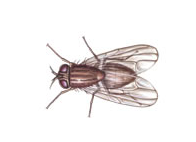
|
Physical Description:
Gray to grayish-black in color and 1/6 to 1/4 inch in length. Female is usually larger than the male.
Damage:
Originate in filth and can carry diseases that may be transmitted to humans. |
Mosquito

|
Physical Description:
Have slender bodies with scaled wings, long legs, and are typically less than 1 inch in length.
Damage:
Bothersome on hot summer days when they swarm around people. Bites show up several hours later as swollen, itchy red bumps on the skin. It is estimated that mosquitos transmit diseases to more than 69 million people every year.
|
Dog Tick
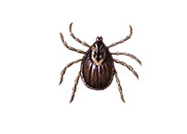
|
Physical Description:
Damage:
|
Fleas
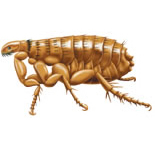
|
Physical Description:
Reddish-brown to black in color and only 1/16 to 1/8 inch. Bodies flattened laterally, appearing hard and polished. Wingless with tube-like mouthparts. Have long legs for jumping and are able to jump up to 7 inches vertically.
Damage:
Bites can cause itching, an allergic reaction with rash, hair loss from scratching and anemia. May also transmit diseases. |
European Hornet
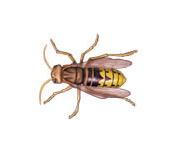
|
Physical Description:
Hornets are from 1/2 to 1 inch long, have a narrow waist with long legs and a stinger. Have a black thorax and abdomen that is marked with white or bright yellow markings depending on the type and construct a paper-like nest that resembles a large, inverted tear shape.
Damage:
Have a lance-like stinger and can sting multiple times. The sting is painful and may be fatal in sensitive individuals. If reaction occurs from sting, contact your physician immediately. |
Indian Meal Moth
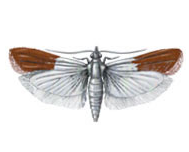
|
Physical Description:
Has a wingspan of approximately 5/8 inch, with the outer third in reddish-copper scales. Hind wings are gray. Larvae appear as white worms with brown heads.
Damage:
|
Norway Rat
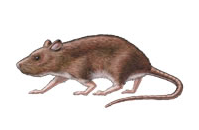
|
|
Roof Rat
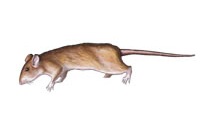
|
|
House Mouse
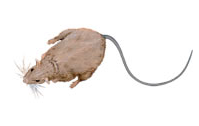
|
|

|
